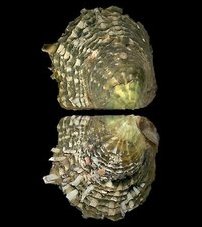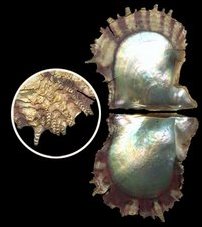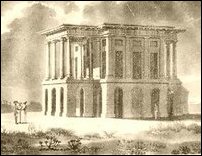Know the Etymology: 79
Place Name of the Day: Thursday, 06 April 2017
Cilāpam, Cilāvat-tuṟai
சிலாபம், சிலாவத்துறை
Cilāpam, Cilāvat-tuṟaiCilāpam
Cilāvat+tuṟai
The place to conduct pearl diving or conch-shell diving
The port to conduct pearl diving
| Cilāpam | also Calāpam: pearl fishery (Tamil, DED 2369); place or port to conduct pearl fishery (Tamil, MTL); Calāpam, Cilākam: place or port to conduct pearl fishery (Tamil, inscriptions, 1086 CE, SII, vii, 1032; 1096 CE, SII, xvii, 623); Salāpam, Silāpam: pearl fishery (Malayalam, DED 2369); Salāpamu: pearl fishery (Telugu, DED 2369); Calāpak-kuḷi: pearl fishery, diving for pearls (Tamil, MTL, Winslow); Kuḷi: (verb) to bathe, to dive for pearls (Tamil, DED 1832); Calāpat-tuṟai: the port or coastal point to go for pearl fishery (Tamil, MTL); Caṅkuc-calāpam: the place to conduct conch-shell diving (Tamil, MTL) |
| Cilāvam | variation of Cilāpam. See box on Cilāpam |
| Tuṟai | place, location, seaport, harbour, bathing ghat (Tamil, DED 3370) |
Cilāpam and Calāpam in Tamil mean pearl fishery or a place to conduct pearl fishery.
Cilāpam is mainly Eezham Tamil usage, while Calāpam is the usage in Tamil Nadu. It is Salāpam and Silāpam in Malayalam and Salāpamu in Telugu.
Halāvata is a Sinhala form found for Cilāpam in recent official records of Colombo, but no dictionary entries attest to this form meaning a place for pearl or conch-shell diving.
The term Calāpam and another variation Cilākam, in the meaning of a pearl-diving place, come in Tamil inscriptions dating from 11th century CE. Around this time, Calāpam appears in Tamil literature also.
The etymology of Cilāpam/ Calāpam is not clear. The terms are not found in Caṅkam literature, even though there are many references to pearl/ conch-shell diving in the corpus. Probably, Cilāpam/ Calāpam has come from a technical usage of the communities such as Paravar and Mukkuvar who were doing the diving, or has come from guilds and authorities that were employing them and conducting the trade in early medieval times.
Caṅkuc-calāpam is another Tamil term found in MTL for conch-shell diving. A place like Cilāpam in Puttalam was mostly engaged in conch-shell diving, while Cilāvat-tuṟai in Mannar was a hub for pearl diving.
* * *Usage of Calāpam and Cilākam in Tamil inscriptions and literature:"முத்திந் சிலாகமும் முத்தமிட்ப் பொதியலும்" (Tamil inscription, 1086 CE, SII, vii, 1032)
"Muttin cilākamum muttamiṭp potiyalum" (Tamil inscription, 1086 CE, SII, vii, 1032)
The place of pearl fishery and the Potiyal hill, the seat of the three branches of Tamil [reference to the southern regions of the Tamil country where the ports for pearl fishery and the Potiyal/ Potuvam/ Potikai hill, known as the seat of the three branches of Tamil are located]
"முத்தின் சலாபமும் முத்தமிட்ப் பொதுவமும்" (Tamil inscription, 1096 CE, SII, xvii, 623)
"Muttiṉ calāpamum muttamiṭp potuvamum" (Tamil inscription, 1096 CE, SII, xvii, 623)
The place of pearl fishery and the Potuvam hill, the seat of the three branches of Tamil [reference to the southern regions of the Tamil country where the ports for pearl fishery and the Potiyal/ Potuvam/ Potikai hill, known as the seat of the three branches of Tamil are located]
"முத்தின் படிக்குச் சலாபம் பணித்தான்" (ஒட்டக்கூத்தர், ராஜராஜ சோழன் உலா, 333)
"Muttiṉ paṭikkuc calāpam paṇittāṉ" (Oṭṭakkūttar, Rājarāja Cōḻaṉ Ulā, 333)
(He) ordered for the establishment of a pearl fishery port to dive for pearls [Paṭi: = Kuḷi: to dive, Tamil, DED 3848, Akanāṉūṟu, 212: 8-9]
* * *Cilāpam heads a division by its name in Puttalam district. The form used in colonial times and continuing in English is Chilaw. The form noticed in Sinhala official records of recent times is Halāvata.
Cilāvat-tuṟai is in Musali division of Mannar district.
* * *Some related place names:Cilā-vattai: Karaithuraippattu, Mullaiththeevu. Probably from Cilāvat-tuṟai; conch-shell diving was taking place in this coast.
* * *Notes:
Ceylon pearl oyster (Piinctada radiata) [Courtesy: www.idscaro.net]

Ceylon pearl oyster (Piinctada radiata) [Courtesy: www.idscaro.net]

The Ceylon Pearl Oyster (Pinctada radiata): The growth in 7 years, from the stage of a young brood to a matured oyster [Courtesy: Tennent's Natural History of Ceylon - 1861]

Pearls of different hue [Courtesy: cst.cmich.edu photos by Shigeru Akamatsu]

A sketch of the Governors mansion at Arippu in its heyday [Courtesy: The Sunday Times, 18 May 1997]
In ancient times, the pearl fishery in the Gulf of Mannār attracted traders from the Greacco-Roman world to China. It was largely under the control of the Pandyas of the ancient Tamil country. The port of Koṟkai, which was their coastal capital (either the present Puṉṉaik-kāyal near Thooththukkudi or Kīḻakkarai near Ramanathapuram), was the main centre for pearl diving.
The king of Jaffna had the control of the pearl banks or part of them from 14th century to the fall of the kingdom to the Portuguese in 1618 CE. The coastal tract from Mannār to Kutiraimalai in Vilpattu was part of the Kingdom of Jaffna.
The pearl fishery was an important source of income for the Portuguese and the Dutch who administered it from Jaffna (as Mannār was under the judisdiction of Jaffna), and they competed with the Maṟava kingdom of Ramanathapuram (Cētupatis) for the control of the pearl banks.
The British had a full control of it, often personally supervised by the British Governmor, but the economic importance of the pearl fishing was lost after early British times.
For a detailed description of the pearl fishery of the Gulf of Mannār, see James Cordiner's “A Description of Ceylon.” Cordiner was an eyewitness to a season's diving that took place at the beginning of 19th century at Cilāvattuṟai.
During colonial times the pearl fishery was regulated and was often given for contract. Allowing a couple of years and sometimes even decades for the pearl oysters to mature or to regenerate, and alternately selecting the pearl banks, the contract used to be given for a month to conduct diving.
As a convention, the contractors during British times were obliged to allow two boats belonging to Ramesvaram temple and one boat of Vēḷāṅkaṇṇi church to participate and take the catch.
Vaitiliṅkac-Ceṭṭiyār during the Dutch times and his son Kantappac-Ceṭṭiyār during early British times monopolized the contract for many seasons. They competed even with the officials of the Dutch and English East India Companies to win this contract. They were not Cheṭṭiyārs from Tamil Nadu, but traditional Vēḻāṇ-Ceṭṭis of Jaffna (who inter-marry with Vēḷāḷar).
The divers were mainly belonging to two communities of Tamils: Paravar from Thooththukkudi and Mukkuvar from Jaffna and Mannār. There were also Arab Muslims.
Paravai is an ancient Tamil word for sea (from Parappu – expanse) and Paravar is a sea-faring community often mentioned in the Canṅkam literature. The community is also mentioned in the early Brahmi inscriptions of the island (Sudarshan Seneviratne). Mukkuvar means those who keep their breath (Mukkutal) and dive (Mukkuḷittal). This community is specialized in pearl and conch diving. Some trace the origins of them to Malaiyāḷam Coast.
Cilāvattṟai was the central place from where boats used to leave for pearl diving until the abandonment of the place in late British times. In fact, this is the nearest convenient place to reach the pearl banks. The boats used to set out after mid-night so that they could reach the pearl banks at dawn and would not waste the daylight of the contract period.
The first English Governor of Ceylon, Frederic North, who personally supervised the pearl fishing at the beginning of 19h century, stayed in a mansion designed and constructed by him for this purpose at a place called Arippu, a few kilometers north of Cilāvattuṟai. The ruins of this mansion, along with other ruins probably of a Dutch fort, are collectively called by a local name, Alli-Rāṇi-Kōṭṭai. Scattered mounds of discarded pearl oyster shells can still be seen at Arippu, a place name which literally means an eroded place. The sea has actually advanced to the walls of the mansion today.
The contractor, his retinue, traders from different parts of the world, jewelry makers, dealers in provisions, keepers of food stalls, Sinhalese fishermen from Negombo to feed the gathering, experts in magical spells to bind sharks from attacking divers, mendicants and entertainers such as jugglers, musicians and dancing women, numbering nearly 50000, stayed at Cilāvattuṟai and at Koṇṭacci which is a couple of kilometers south of Cilāvattuṟai. This temporary town used to continue functioning for one or two years, to complete the processing of pearls and trade deals.
Cilāvattuṟai ceased to be the center for pearl fishing by the end of 19th century. When the renowned writer Leonard Woolf, then a young civil servant of the Jaffna Kachcheri, was appointed superintendent of the pearl fishery in 1906, it was conducted from Maṟiccukkaṭṭi, some kilometers south of Koṇṭacci along the border of Mannar and Puttalam districts. It was the last pearl fishery directly conducted by the government. The failure of lease and the arrival of cultured pearl from Japan in recent times brought an end to the pearl fishery of Mannar.
* * *
Trans-oceanic trade routes of the past. [Satellite photo by NASA, Visible Earth, Legend by TamilNet]

The colonial ruins at Arippu, 4 km north of Chilaavaththu'rai [Courtesy: The Nation, 16.07.2006]
Previous columns:
External Links:














